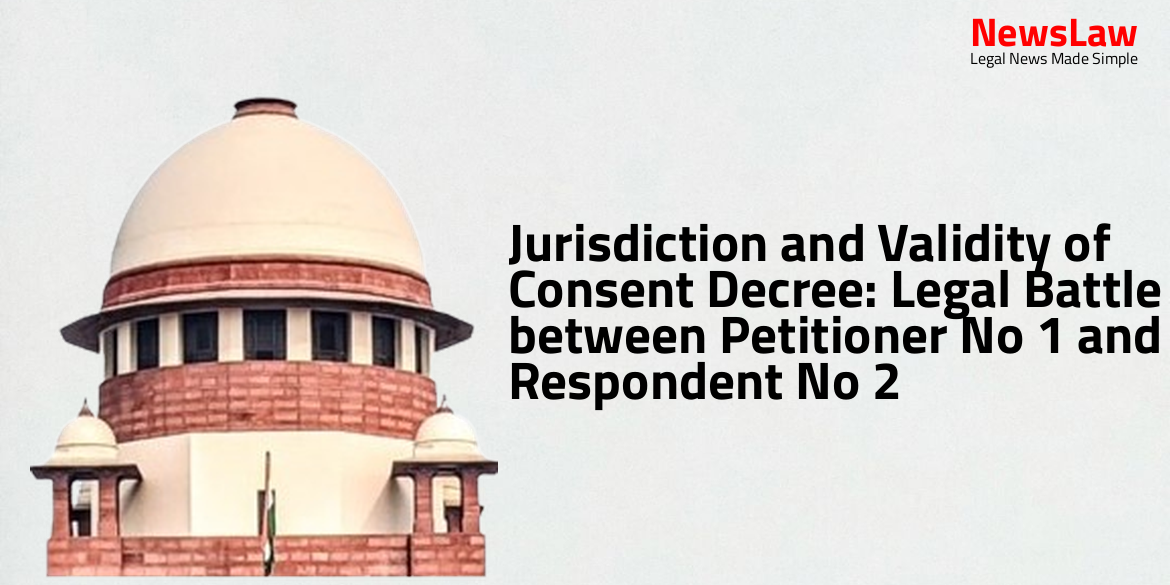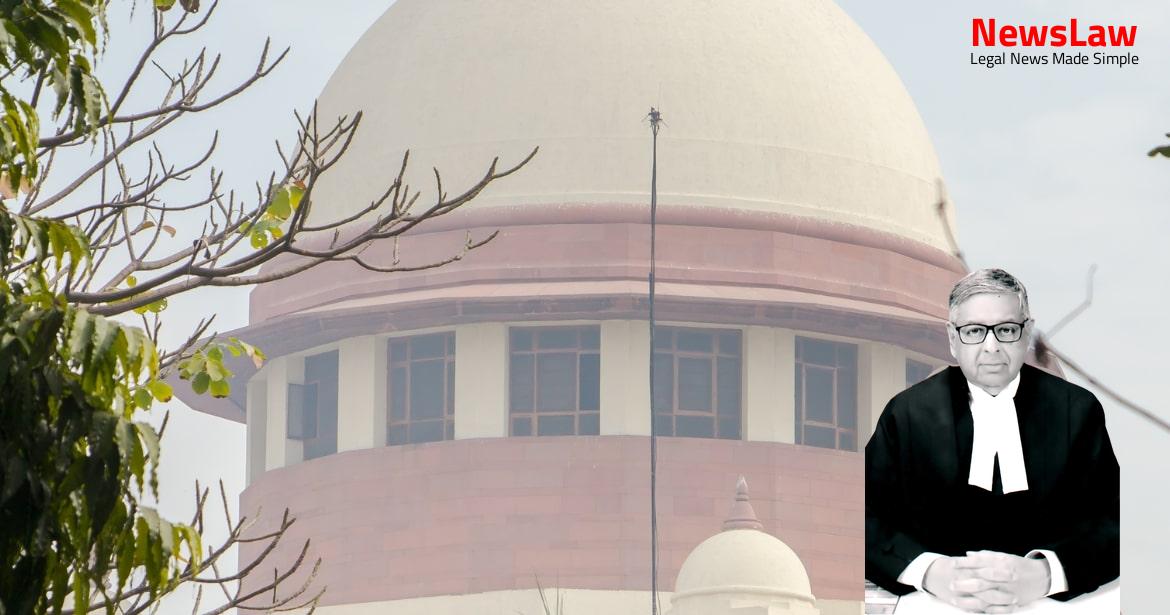Explore the detailed legal analysis of a complex case involving land acquisition and industrial development. The Division Bench’s judgment is under scrutiny, highlighting the intricacies of the Karnataka Industrial Areas Development Act, 1966. This summary focuses on the court’s evaluation of public interest, statutory procedures, and the distinct purpose of planned industrial development. Follow along for a deep dive into the legal considerations shaping this case.
Facts
- The Division Bench allowed the appeals and quashed the acquisition proceedings for the entire areas.
- Several parties including landowners and government authorities have filed appeals challenging different judgements related to the acquisition proceedings.
- The notifications under Sections 3(1), 1(3) and 28(1) of the Karnataka Industrial Areas Development Act, 1966 were quashed by the Division Bench.
- The judgment emphasizes the greater public purposes over individual landowner rights.
- The Court declined to interfere in the acquisition proceedings based on the above reasons.
- The Government of Karnataka issued a Government Order on 22.03.2006 modifying the approved project for a pellet plant and an integrated steel plant in favor of MSPL and AISL.
- The writ petition challenges the grant under Sections 1(3) and 3(1) of the 1966 Act, with the area sought to be acquired being only 4 acres and 34 guntas.
- Over 90% of the land owners covering 90% of the acquired area accepted the compensation, with a small percentage agitating their grievances through writ petitions.
- KSPCB consented to MSPL for establishing a pellet plant on 02.08.2008 and 01.12.2008 under relevant State Acts.
- The Karnataka Industrial Areas Development Act, 1966 aimed at promoting industrial areas and development of industries by establishing an Industrial Areas Development Board.
- Notifications were issued under Section 28(4) of the 1966 Act for the land required by MSPL and AISL, with objections not raised to the provided chronology.
- A significant portion of land was acquired for MSPL, with a landowner in a specific petition owning less than 4% of the total acquired land for MSPL.
- The project involved the establishment of an iron ore palletization plant and an integrated steel plant, with legal challenges brought forward against notifications under the 1966 Act.
Also Read: Balancing Private Grievances and Public Interests
Issue
- Division bench quashed the acquisition and related notifications under specific sections of the 1966 Act.
- Issue to be considered: Whether the acquisition could have taken place without environmental clearance.
- Key arguments by counsels to be considered in the appeals.
Also Read: Quashing of Criminal Proceedings Based on Insufficient Allegations
Arguments
- The petitioners raised two main arguments before the Single Judge: (a) absence of notification under Section 1(3) of the KIADB Act, and (b) the acquisition being only for one company, which they argued was not for public purpose.
- The State Government had issued a notification bringing Chapter VII of the KIADB Act into force in the relevant area for industrial development.
- Acquisition under the Act is for the purpose of developing industrial estates or areas, not specifically for a single company.
- The Act aims to create planned industrial areas for the growth and development of industries in the State with socio-economic benefits.
- The High Court was requested to set aside the impugned judgment based on arguments made by the petitioners’ counsel.
- The High Court’s review of approval for the project and the compliance with statutory procedures were challenged by the petitioners.
- Landowners raised complaints regarding the acquisition process under Section 28 of the 1996 Act.
- The Single Judge’s decision was based on considerations of public interest and welfare of the state of Karnataka.
- Various legal arguments were presented regarding the procedural differences between the Land Acquisition Act and the Act in this particular case.
- A significant portion of landowners did not challenge the acquisition, with only 10% filing writ petitions.
- The Act’s purpose is distinct from the Land Acquisition Act, focusing on planned industrial development in the state.
- KIADB cannot acquire lands for a single company/private industrialist, which is improper and not in the public interest.
- The land owner-respondents have not accepted any compensation.
- Approval of project by SHLCC under the 2002 Act does not grant immunity against illegalities/irregularities in land acquisition.
- The Division Bench’s judgment dated 22.03.2012 is deemed correct on law and facts. Thus, the writ appeal dismissal by the Division Bench in the impugned judgment dated 14.12.2011 is in error and should be set aside.
Also Read: Reversal of Acquittal: High Court Convicts Accused in Murder Case
Analysis
- The Division Bench expressed personal policy views and value judgments on the concept of ‘development’ involving interference with nature.
- The challenge to the acquisition was made by a minority (10%) of landowners, while the rest had accepted compensation.
- Comparison with the Maharashtra Industrial Development Act was questioned in the judgment.
- The High Court’s inclusion of value judgments and policy views was a point of contention.
- Cases cited to support the legality of land acquisition by private companies.
- The High Court’s views on pollution caused by industries and the tendency of courts to favor acquisition were criticized.
- The necessity of considering the livelihood and dignity of people affected by acquisition was emphasized.
- The High Court’s decision to quash the acquisition was questioned in light of previous judgments.
- The judgment reflected a critical view of joint stock companies and acquisition processes in the name of public interest.
- The State Government examined the request of MSPL and AISL for modification of its Government Order dated 22.12.2005.
- The SHLCC approved the projects proposed, which included setting up a software technology park and other infrastructural facilities.
- The land acquisition under the Karnataka Industrial Areas Development Act, 1966 can only be for the purpose of developing industrial areas or for promoting the establishment and orderly development of industries.
- Acquisition for a single company or for a non-applicant (AISL) has been challenged based on the specific provisions of the Act.
- Simultaneous issuance of notifications under different sections of the Act, without clear application of mind or procedural adherence, raises concerns about the legality and validity of such notifications.
- The court noted that specific procedures and consultations were followed in the process of land acquisition and project approval.
- The Court also considered environmental clearances and the role of statutory committees in the decision-making process.
- The judgment emphasized the importance of adhering to the statutory provisions and constitutional mandates in land acquisition and industrial development processes.
- The State Government can acquire land for development by the Board or for any other purpose in furtherance of the Act.
- Regulation 13 allows the Board to allot plots in special cases for industrial establishment or provision of amenities.
- The functions and general powers of the Board are outlined in sections 13 and 14 of the 1966 Act.
- The Board has the power to acquire and hold property, provide amenities, lease or sell property, and delegate powers to the Executive Member.
- Chapter VII of the Act deals with land acquisition and disposal, with the Land Acquisition Act, 1894 applying mutatis mutandis.
- The 2002 Act establishes the constitution of the Board and its general powers for the establishment and development of industrial areas in Karnataka.
- Division Bench made an error in quashing the acquisition proceedings.
- AISL’s estimated project is approximately Rs. 2092 crores.
- AISL’s project would provide employment to at least one thousand persons.
- Less than 10% of landowners are challenging the acquisition of 914 acres by AISL.
- MSPL’s employment of approximately 300 persons is alleged to be double the projected number of employees in the proposal.
Decision
- The appeals filed by MSPL, AISL, KIADB, and State of Karnataka are allowed.
- The appeal of Syed Ahmed, owner of 14.35 acres out of the total 705.99 acres acquired for M/S BMM Ispat Ltd., is dismissed.
- No costs are awarded.
- Pending applications, if any, are disposed of.
- The Division Bench’s judgment dated 22.03.2012 is set aside, and the writ petitions are dismissed as per the learned Single Judge’s judgment dated 17.03.2009.
Case Title: M/S. M.S.P.L. LIMITED REP. BY EXECUTIVE DIRECTOR MR. MEDAVENKATAIAH Vs. THE STATE OF KARNATAKA AND ORS. DEPARTMENT OF COMMERCE AND INDUSTRY (2022 INSC 1060)
Case Number: C.A. No.-004678-004678 / 2021



